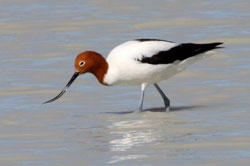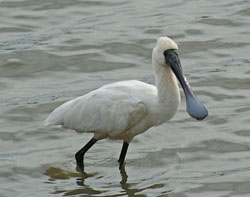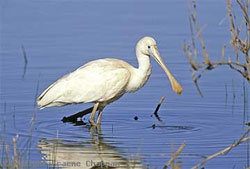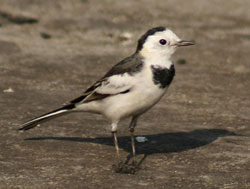Tom Parkinson's monthly column, introducing the diverse range of flora and fauna on show at Sanctuary Lakes.
One of the joys of living in Sanctuary Lakes is the variations of walks available locally - whether it is around the Boulevards, the Golf Course fringes, Skeleton Creek or the magnificent Saltmarshes and Beaches of the Cheetham Wetlands.
As with all of Sanctuary Lakes Resort, the Flora and Fauna of the Wetlands is extremely varied and rich. Recently I took a walk around the Wetland with my English 'six monther' friend Richard - a regular daily walker, who has become a devotee to this area, particularly the animal and bird life. As I have often written, there are annually at least 300 different species of birds living between Sanctuary Lakes and Point Wilson. That is roughly 3% of the world’s population of bird species in the thin 25km strip of wetland. We had heard there were three wader birds with very interesting bills, presently enjoying a residence on the Wetland, so we went off in search of them and fortuitously, also found something very rare.
We started our walk on the Beach at the tip of Point Cook Homestead. This was once part of the huge pastoral estate belonging to the Chirnside family. The Homestead, stables, and outbuildings were the original family home built in 1857. One of the many Chirnside race horses stabled at the Homestead was the famous Haricot who won the Melbourne Cup in 1874. The Chirnside family also built Werribee Park Mansion, although the head of the household Thomas moved back to the Homestead to be near his beloved race horses and enjoy his daily wetland shooting party, bagging foxes, rabbits and ducks. It is from one of the shooting party's spoil that Richard, with his eyes keenly looking ground ward, found a 100 year old Musket shell from one of the Chirnside shooting parties. Richard tells me they are very common and always finds at least one ancient Musket shell on his walks around the Wetlands.
After a kilometre walking along the Beach we cut in land taking a track that leads to the Viewing Tower. The track passes several mud flats and we see our first "Bill" curiosity - the Red-necked Avocet recurvirostra novaehiiandiae.
 Red-necked Avocet also known as the Australian avocet, cobbler, cobbler's awl, and painted ladyThe Red-necked Avocet is mostly white with chestnut brown head and neck. Two black streaks along the back and black wing bars and tips. The legs are long and pale grey. It has white eye-ring and a long distinctive elegant black bill that curves upwards and is used to forage in the water of shallow wetlands. By sweeping the bill back and forth through the water in a scything motion, tiny aquatic invertebrates are caught with each sweep of the bill. The Avocet apparently locates these insects and crustaceans by using its sense of touch. Not a lot is known of their life history; they breed around inland ponds and lakes. They are nomadic and after breeding make their way either to intertidal wetlands or inland lakes that have a salty bias. They are known to travel in large flocks of thirty plus, but I have never seen more than a flock of six on the Cheetham Wetland and on this walk we only see two.
Red-necked Avocet also known as the Australian avocet, cobbler, cobbler's awl, and painted ladyThe Red-necked Avocet is mostly white with chestnut brown head and neck. Two black streaks along the back and black wing bars and tips. The legs are long and pale grey. It has white eye-ring and a long distinctive elegant black bill that curves upwards and is used to forage in the water of shallow wetlands. By sweeping the bill back and forth through the water in a scything motion, tiny aquatic invertebrates are caught with each sweep of the bill. The Avocet apparently locates these insects and crustaceans by using its sense of touch. Not a lot is known of their life history; they breed around inland ponds and lakes. They are nomadic and after breeding make their way either to intertidal wetlands or inland lakes that have a salty bias. They are known to travel in large flocks of thirty plus, but I have never seen more than a flock of six on the Cheetham Wetland and on this walk we only see two.
The track takes us to the William Kelly designed observation tower. I would encourage everyone to experience the magnificent 360 degree view from "The Tower". The City and St Kilda to the east, Williamstown and Altona to the Nor' east, Bellarine and the You Yangs to the south and of course surrounded by the pools and mud flats of the Wetlands.
From the tower we took the track north to Sanctuary Lakes and Skeleton Creek where we found our two other "Bill" curiosities feeding in the same pond. Firstly the more common in Sanctuary Lakes, the Royal Spoonbill Platalea regia.
 Royal Spoonbill Platalea regiaThe royal spoonbill is a large, white bird with a black, spoon-shaped bill. It is approximately 80 cm tall, a wading bird with long black legs for walking easily through the shallows. The Royal Spoonbill is carnivorous, catching crustaceans, aquatic bugs and worms, shrimps, small fish and insects by sweeping its bill through shallow water. When slow sweeping, the spoonbill treads warily with its bill perpendicular to the water surface with its bill tip open about 2 to 4 cm, sweeping an arc of around 100 degrees in front of the bird. The bird walks slowly, kicking up debris and small animals from the bottom of the body of water, which it senses and catches with its bill. When an item is sensed, the spoonbill switches to intensive sweeping of the small area. Once food is caught, it lifts its bill up and lets the items slide down its throat. It will bash shrimps and snails against hard objects to remove their shells.
Royal Spoonbill Platalea regiaThe royal spoonbill is a large, white bird with a black, spoon-shaped bill. It is approximately 80 cm tall, a wading bird with long black legs for walking easily through the shallows. The Royal Spoonbill is carnivorous, catching crustaceans, aquatic bugs and worms, shrimps, small fish and insects by sweeping its bill through shallow water. When slow sweeping, the spoonbill treads warily with its bill perpendicular to the water surface with its bill tip open about 2 to 4 cm, sweeping an arc of around 100 degrees in front of the bird. The bird walks slowly, kicking up debris and small animals from the bottom of the body of water, which it senses and catches with its bill. When an item is sensed, the spoonbill switches to intensive sweeping of the small area. Once food is caught, it lifts its bill up and lets the items slide down its throat. It will bash shrimps and snails against hard objects to remove their shells.
The Royal Spoonbill forms monogamous pairs for the duration of the breeding season. They are very social birds and will nest in colonies alongside many other waterbirds. They build their nests upon the crown of trees and usually re-use old nests year after year.
Wading almost beside the Royal Spoonbill is our third "Bill" curiosity - the Yellow Billed Spoonbill Platalea flavipes.
 Yellow Billed Spoonbill Platalea flavipesThe Yellow Bill is slightly larger than its cousin the Royal Bill. Also its off-white body colour, yellow legs and long, pale yellow, spoon-shaped bill clearly make it easily identifiable from the Royal. The face is pale grey bare skin with a narrow black edging around the bill in breeding birds.
Yellow Billed Spoonbill Platalea flavipesThe Yellow Bill is slightly larger than its cousin the Royal Bill. Also its off-white body colour, yellow legs and long, pale yellow, spoon-shaped bill clearly make it easily identifiable from the Royal. The face is pale grey bare skin with a narrow black edging around the bill in breeding birds.
Yellow Bill also inhabits fresh water swamps and waterways, but unlike the Royal it feeds by day and night. It seems to have a different sensitivity to the Royal but eats similar water insects, crustaceans, fish and molluscs. Again like the Royal when feeding, Yellow Bill walks through the shallow water stirring up sand, mud and organisms from the bottom while the bill sweeps from side-to-side through the water; if anything touches the inside of the sensitive spoon-shaped tip it is grasped and eaten.
Yellow Bills breed mainly by inland ponds and lakes. They return to the same breeding area from September to April year after year. The nest is a large collection of sturdy sticks up to 20 metres above water or ground, usually in trees or bushes growing in water. Up to four eggs are laid. The young are fed by regurgitation from both parents. At about seven weeks they can fly and follow their nomadic adults travelling to and from inter tidal feeding locations.
Now for our surprise. About the last five hundred metres of our journey we saw a silhouette of what looked like the friendly Willie Wagtail giving that very individual wagtail's fly catching, jerky flight movements. Getting closer we noticed it had totally different marking and colours to the Willie Wagtail. First thought, it was a Wagtail with a leucistic plumage change, but quickly looking through our bird books we could see it was in fact the very rare vagrant the White Wagtail.
 White Wagtail motacilla albaThis extremely rare bird for Australia has travelled or been blown down from South East Asia. But dispite its vagrant status, increasingly frequent sightings suggest that the White Wagtail has a wider dispersment here than first thought and is now starting to breed here. There have been a few certified sightings at the Werribee Water Farm, which could have been the one we spotted but it seems more likely that there are few White Wagtails in our area.
White Wagtail motacilla albaThis extremely rare bird for Australia has travelled or been blown down from South East Asia. But dispite its vagrant status, increasingly frequent sightings suggest that the White Wagtail has a wider dispersment here than first thought and is now starting to breed here. There have been a few certified sightings at the Werribee Water Farm, which could have been the one we spotted but it seems more likely that there are few White Wagtails in our area.
Waterbirds are nomadic and some migratory, which means every walk along the Cheetham Wetlands can become a new expierence. Added to that are the multitude of strange colourful saltmarsh plants along the banks of the Saltpans and tidal pools. Try the walk, I can guarantee it will be enjoyable and often truly memorable.
And the exercise ain’t bad either.